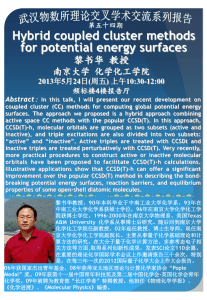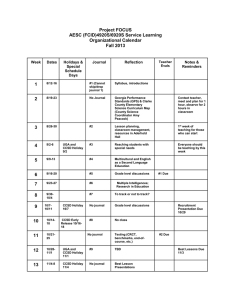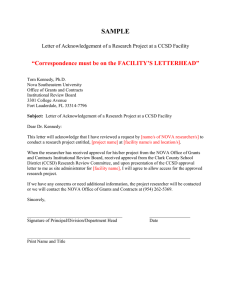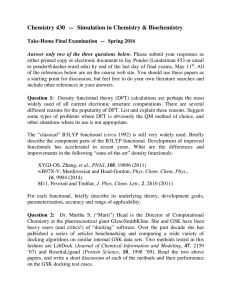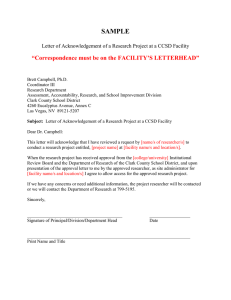ELECTRONIC STRUCTURE THEORY
advertisement
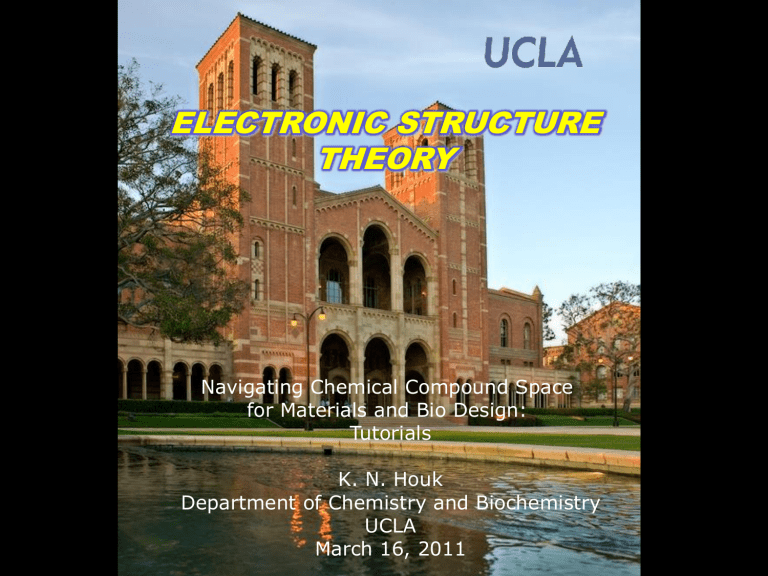
ELECTRONIC STRUCTURE THEORY Navigating Chemical Compound Space for Materials and Bio Design: Tutorials K. N. Houk Department of Chemistry and Biochemistry UCLA March 16, 2011 Navigating Chemical Compound Space for Materials and Bio Design: Tutorials Electronic Structure Theory Generalities and history Wavefunction electronic structure theory Benchmarking, accuracies General programs for quantum mechanics calculations Some applications from our group Thanks to six great postdocs in my group: Peng Liu Gonzalo Jimenez Silvia Osuna Nihan Celebi Steven Wheeler Arik Cohen Quantum Mechanics Heisenberg–Schrödinger WFT Reproduce and Predict Chemistry? Post-HF Methods Møller– Plesset: MP2, MP3, ... CI, MCSCF, GVB, CCT Born–Oppenheimer Orbital Approximation Hartree–Fock Complete Basis Set Ab initio Kohn–Sham LCAO LCAO Roothaan–Hall KS-LDA Methods LSDA, Xa SVWN Semiempirical Hybrid Methods HMO, PPP EH, CNDO, INDO MNDO, AM1, PM3, PM6 Half & Half KS Methods Non LDA Local Density Approximation (LDA) Hartree–Fock–Slater Approximate Hamiltonian Parametrization Thomas–Fermi–Dirac Hohenberg–Kohn Schrödinger Eq. ? DFT Relativistic Effects (Dirac) BLYP BP86 BPW91 Generalized Gradient Approximation (GGA) B3LYP B3P86 B3PW91 The underlying physical laws necessary for the mathematical theory of a large part of physics and the whole of chemistry are thus completely known, and the difficulty is only that the exact application of these laws leads to equations much too complicated to be soluble. It therefore becomes desirable that approximate It therefore becomes desirable that practical methods of applying approximate practical methodsquantum of applying mechanics should beshould developed, which can lead quantum mechanics be developed, to an explanation main features which can lead to of an the explanation of theof main complex of atomic systems without toowithout much features complex atomic systems computation. too much computation. Paul A. M. Dirac Proceedings of the Royal Society of London. Series A, Containing Papers of a Mathematical and Physical Character, Vol. 123, No. 792 (1929) The Nobel Prize in Physics 1933 Erwin Schrödinger, Paul A.M. Dirac 65 years later….. John Pople Walter Kohn The Nobel Prize in Chemistry 1998 The Nobel Prize in Chemistry 1998 was divided equally between Walter Kohn "for his development of the density-functional theory" and John A. Pople "for his development of computational methods in quantum chemistry". Gaussian, Inc. (since 1987) Introduction to ab initio Molecular Orbital Theory Ĥ E Hˆ Hˆ N Hˆ e Born-Oppenheimer Approximation e N Electronic Schrödinger Equation Hˆ e e Ee e 2 Hˆ e 2m electrons i Kinetic energy 2 i electrons nuclei i A electrons ZA 1 ri R A ri r j i j Coulomb attraction (nuclei-electrons) Electronic repulsion Ab Initio Molecular Orbital theory consists of a family of methods to solve approximately the Electronic Schrödinger Equation without parameterization Eelec 0 * elec Hˆ elec elec dr 0 Eelec elec Hˆ elec elec * elec elec dr = 1 (normalization) Dirac “bra-ket” notation for integrals The Schrödinger equation can be solved analytically (‘exactly’) only for the simplest systems (H, He+). Variational Principle: E'(F’') Approximate energies, trial wavefunctions E'' (F'') E'''(F''') Exact energy, real wavefunction Eelec (elec) Hartree-Fock Theory Assume e as a single antisymmetric product of one-electron functions (molecular orbitals) e r1 , r2 1 1 r1 2 r2 2 r1 1 r2 e r2 , r1 2 For a general N-electron system, we can write this antisymmetric product as a Slater Determinant Linear Combination of Atomic Orbitals Expansion of orbitals in terms of some basis functions centered on the nuclei: Unoccupied (virt) c coefficients b a i cia a a basis functions k j Linear Combination of Atomic Orbitals (LCAO) i Occupied (occ) Hartree-Fock equations (eigenvalue equations) for each molecular orbital: Fˆi ii orbital energy Fock operator 1 2 M Z A occ ˆ ˆ F i 2 J j 1 Kˆ j 1 2 A riA j Coulomb operator Exchange operator i 1, 2, ..., N molecular orbital 1 Jˆ j 1 i (1) i (1) j (2) i (1) j (2) ij ij r12 1 Kˆ j 1 i (1) i (1) j (2) j (1)i (2) ij ji r12 Substituting this expansion in the Schrödinger equation solution: * ˆ c H c * ia a ia a r Hˆ elec r 0 a a E 0 * * 0 r 0 ciaa ciaa r a a H a E S a 0 a 1 1 H na E S na 0 a c a c H a a c a c Sa a i i i i H11 E S11 H12 E S12 H1n E S1n H 21 E S 21 H 22 E S 22 H 2n E S2n H n1 E S n1 cia and E are unknown Minimum 0 Roothaan-Hall equations H n 2 E S n 2 H nm E S nm solved by an iterative numerical method: self-consistent field (SCF) Solution yields N “occupied” orbitals and (M – N) “unoccupied” orbitals The SCF Procedure occ D 2 ci c i i Adapted from Cramer, C. J., Essentials of Computational Chemistry, Theories and Models. Second ed.; Wiley: 2004. The SCF Procedure and Geometry Optimization occ D 2 ci c i i Density matrix D describes how much each basis function contributes to elec. Adapted from Cramer, C. J., Essentials of Computational Chemistry, Theories and Models. Second ed.; Wiley: 2004. The Hartree-Fock approximation can be applied with or without restrictions on the spins of the MOs. Restricted (RHF) Closed shell E a/ RHF singlet The Hartree-Fock approximation can be applied with or without restrictions on the spins of the MOs. Restricted (RHF, ROHF) and unrestricted (UHF) solutions: Closed shell E Open shell a/ a/ RHF singlet ROHF doublet a UHF singlet a UHF doublet What molecular properties can be calculated? R: F: B: I: Nuclear positions External electric field External magnetic field Internal magnetic field ¶2 E ¶ R2 Harmonic vibrational frequencies (IR) ¶2 E ¶F2 Electric polarizability Magnetic susceptibility ¶E ¶R Energy gradient (Forces) ¶2 E ¶ B2 ¶E ¶F Electric dipole moment ¶2 E ¶I 2 ¶E ¶B Magnetic dipole moment ¶E ¶I Hyperfine coupling constants (EPR) Spin-spin coupling (J) ¶2 E ¶R¶E IR absorption intensities ¶2 E ¶B¶I Nuclear magnetic shielding (d) ¶2 E ¶B¶F Circular dichroism … and many others Potential Energy Surface (PES) E r1 r2 Nuclear coordinates Basis Sets 1.0 STO GTO 0.8 0.8 0.6 0.6 Radial part Radial part 1.0 0.4 0.4 0.2 0.2 0.0 0.0 0.0 0.5 1.0 1.5 2.0 r Slater type orbitals (STOs) STO GTOs STO-3G 0.0 0.5 1.0 1.5 2.0 r Gaussian type orbitals (GTOs) STO The analytical form of the two-electron integrals is computationally expensive. The quadratic dependence on r makes the analytical form of the two-electron integrals quite easy. Linear combination of GTOs Classification of Basis Sets Minimal Basis Sets Every occupied atomic orbital is represented using a single basis function, which corresponds to the smallest set that one could consider. First row elements: two s-functions (1s and 2s) and one set of p-functions (2px, 2py, 2pz) Double Zeta (DZ) A better representation can be obtained combining 2 GTOs in a different proportion to represent every atomic orbital. Triple Zeta (DZ) First row elements: four s-functions (1s, 1s’, 2s, 2s’) and two sets of p-functions (2px, 2py, 2pz and 2px’, 2py’, 2pz’) Quadruple Zeta (DZ) split valence Calculations are usually simplified applying a DZ only for the valenceorbitals, and a single GTO is used to represent the inner-shell orbitals. Examples of Basis sets STO-3G, 3-21G, 6-31G, 6-311G, cc-pVDZ, cc-pVTZ, … Effective Core Potential (ECP) Valence electrons EXPLICITLY Core electrons POTENTIAL Coulomb repulsion effects Pauli principle Relativistic effects Semi-empirical Methods: Overview INDO/S ZINDO/S SAM1 Ridley, Zerner Dewar, Jie, Yu MINDO/3 Bingham, Dewar, Lo Methods restricted to π-electrons: Rocha Stewart PPP CNDO SINDO1 Hückel Pople Pople Nanda, Jug 1930 1953 1965 HMO RM1 PM3 1973 1963 1980 1977 AM1/d 1989 1993 Voityuk Rosch Stewart 2000 2006 1996 2002 2007 1985 EHT MNDO MNDO/d PM6 Hoffmann Dewar, Thiel Thiel, Voityuk Stewart AM1 Dewar,Stewart Methods restricted to all valence electrons: PDDG/PM3 PDDG/MNDO Jorgensen CNDO (Complete Neglect of Differential Overlap) INDO (Intermediate Neglect of Differential Overlap) NDDO (Neglect of Diatomic Differential Overlap) Semi-empirical Methods: Overview Methods restricted to π-electrons Methods restricted to all valence electrons: 1963 1965 1930 1977 1980 CNDO (Complete Neglect of Differential Overlap) INDO (Intermediate Neglect of Differential Overlap) INDO NDDO + + All integrals involving different atomic orbitals IGNORED All 2-center 2e- integrals (not Coulomb) NEGLECTED ELECTRON CORRELATION EFFECTS INCLUDED Use of empirical parameters 2007 NDDO (Neglect of Diatomic Differential Overlap) Overlap matrix: UNIT matrix 1e- integrals involving 3 centers = ZERO 3- and 4-center 2e- integrals NEGLECTED Remaining integrals: PARAMETERIZED Semi-empirical Methods: Benchmarks Activation Barriers (kcal/mol) PDDG-PM3 PDDG-MNDO PM3 AM1 MNDO Exp 49,8 45,6 44,8 42,8 41,8 41,1 41,4 36,3 33,3 30,0 27,1 23,8 39,8 39,7 37,9 41,3 35,1 32,0 34,1 40,6 40,2 35,3 39,0 32,9 25,7 25,1 22,1 18,5 4,5 1 2 3 4 Repasky, M. P.; Chandrasekhar, J.; Jorgensen, W. L. J. Comp. Chem. 2002, 23, 1601. 5 Semi-empirical Methods: Benchmarks Overall MAEs for Isomerization Energies (kcal/mol) PDDG-PM3 PDDG-MNDO 3,7 PM3 AM1 MNDO 4,0 2,9 2,1 2,3 Repasky, M. P.; Chandrasekhar, J.; Jorgensen, W. L. J. Comp. Chem. 2002, 23, 1601. Electron Correlation monodeterminantal approximation treated the average Coulombic interaction of the electrons neglected instantaneous electron-electron interactions (electron correlation) Ab initio HF limit Correlation Energy Roothaan–Hall Hartree–Fock (not a physical entity) Exact solution overestimated energy Limitations of HF Theory Schrödinger Eq. The Correlation Energy E H · + H· “exact” at HF level H–H Hartree-Fock calculations recover ~99% of total energy HF underestimated binding energy HF energy Exact (correlated) energy Why is the correlation energy so important? Due to the absence of correlation energy, HF calculations usually lead to: - too large stretching bond energies - too short bonds - too large vibrational frequencies - wavefunctions with a too ionic character. too large activation energies for bond formation reactions. Electron Correlation Methods To go beyond HF, • must include electron-electron interaction explicitly (Electron Correlation) • must also move beyond the single-determinant picture Electron Correlation Methods Configuration Interaction (CI) CISD CISD(T) CISDT CISDTQ …… Coupled Cluster (CC) CCSD CCSD(T) CCSDT QCISD QCIST(T) …… Many Body Perturbation Theory (MBPT) MP2 MP3 MP4 …… Configuration Interaction (CI) Unoccupied (vir) c c c b b b a a a Occupied (occ) CI: wavefunction expansion of Slater determinants in which electrons are “excited” to unoccupied orbitals. k k k j j j i i i 0 S-type: i HF: D-type: ij ab a … Full CI: include all possible Slater determinants CI cI I c0 0 cia ia I i ,a ab ab c ij ij i j , a b Solving CI Secular Equations Solving the set of CI secular equations == diagonalizing the CI matrix Hij is evaluated by expanding it in a sum product of MO’s MO’s are expanded in AO’s Combinatorial Issues with CI Calculations Number of electronic configurations grows factorially with the basis-set size Excitation Level (n) Method Total Electronic Configurationsa 1 CIS 71 2 CISD 2556 3 CISDT 42,596 4 CISDTQ 391,126 5 CISDTQ5 2,114,666 … …… …… Ne Full CI 30,046,752 a Number of singlet configurations for H2O with 6-31G(d) basis set (19 basis functions) R. J. Harrison and N. C. Handy, Chem. Phys. Lett. 95, 386 (1983). c N = number of electrons e b Truncated CI Methods In Practice, we truncate the N-particle expansion: Excitation Level (n) Method Total Electronic Configurationsa % Corr. Enery Recoveredb 1 CIS 71 0 2 CISD 2556 94.7 Applied to a large variety of systems 3 CISDT 42,596 95.5 T contributions are relatively small 4 CISDTQ 391,126 99.8 Results close to full CI 5 CISDTQ5 2,114,666 - … …… …… Ne Full CI 30,046,752 a 100 ECIS = EHF (Brillouin’s theorem) Excitations above Q-type are not important Only feasible to very small molecule and basis set Number of singlet configurations for H2O with 6-31G(d) basis set (19 basis functions) R. J. Harrison and N. C. Handy, Chem. Phys. Lett. 95, 386 (1983). c N = number of electrons e b Coupled Cluster (CC) Theory Alternatively, the CI wavefunction can be described as Tˆ CC e 0 The excitation operator TˆI Tˆ Tˆ1 Tˆ2 TˆN generate all possible determinants having I excitations from the reference occ vir Tˆ1 0 tia ia i a occ vir Tˆ2 0 tijab ijab i j a b Truncated Coupled Cluster theory: CCSD: CCSD(T): Tˆ Tˆ1 Tˆ2 Tˆ1 Tˆ2 CCSD e 0 CCSD with perturbative triples corrections CCSD(T) with large basis-set is the “gold standard” for a single ground state calculation. CCSD(T) Procedure Perturbation Theory basic idea: Treat correlation into a series of corrections to an unperturbed starting point • Start with a system with known Hamiltonian, and eigenfunctions, . • Calculate the changes in these eigenvalues and eigenfunctions that result from a small change, or perturbation, in the Hamiltonian for the system. total Hamiltonian 0 Hˆ Hˆ Vˆ unperturbed system , eigenvalues, perturbation , Møller-Plesset Perturbation Theory Second order Møller-Plesset Perturbation Theory (MP2) E0 2 0* ˆ 0 0* ˆ 0 V d 0 i 0 V i d i 0 E0 Ei 0 0 N 1 N N N 1 Vˆ J i Ki i 1 j i rij i 1 j 1 Third order Møller-Plesset Perturbation Theory (MP3) additionally includes the third order correction to the energy. Nth order Møller-Plesset Perturbation Theory is called MPn. Calculations up to MP4 are common. Møller-Plesset Perturbation Theory Advantages of MP methods: • MP2 captures ~ 90% of electron correlation Disadvantages of MP methods: • MP methods are not variational E HF MP3 SCS-MP2 MP4 MP2 Extrapolation Methods Exact Solution to the Schrödinger Equation Basis Set complete basis set … TZ2P DZP DZ SZ HF/ minimal BS HF MP2 QCISD CCSD CCSD(T) … Electron Correlation Full CI A Simple Example of Extrapolation Method Basis Set complete basis set … Ecorr HF large BS CCSD(T) large BS TZ2P DZP EBS DZ SZ Ecorr HF small BS HF EBS MP2 QCISD CCSD(T) small BS CCSD CCSD(T) … Electron Correlation Full CI Extrapolation Methods Common Extrapolation Methods: • Gaussian-n (G2, G2(MP2), G3, etc.) • Complete basis set (CBS-Q, CBS-QB3, CBS-RAD, etc.) • Weizmann-n (W1, W2, etc.) • HEAT (thermochemistry calculations) • Focal point methods G2 Theory • Geometry optimized at the HF and MP2/6-31G(d) level. MP4 with a relatively small basis set zero-point vibrational energy at the HF/6-31G(d) level basis set corrections to the 6-311+G(3df,2p) basis set higher-level correction correlation energy corrections to the QCISD(T) level L. A. Curtiss, K. Raghavachari, G. W. Trucks, and J. A. Pople, J. Chem. Phys., 94 (1991) 7221-30. MAE / kcal mol-1 Performance of G2 and DFT for Enthalpies of Formation Curtiss, L. A. et al., J. Chem. Phys. 1997, 106, 1063. Test Set: G2/97 (148 Hf) G3 and G4 Theories • G3 – – – – new basis sets for single point energies spin–orbit correction and correction for core correlation MAD for G2/97 set: 1.01 kcal/mol requires less computational time than G2 • G3(MP2) – use MP2 instead of MP4 in single point energy calculations – increase MAD to 1.30 kcal/mol • G3B3: G3 using B3LYP geometries – MAD for G2/97 set: 0.99 kcal/mol • G4 – – – – for molecules with 1st, 2nd, and 3rd row main group atoms use CCSD(T) instead of QCISD(T) for correlation corrections B3LYP geometries Larger basis sets for single point energy calculations G3: a) Curtiss, L. A. et al., J. Chem. Phys. 1998, 109, 7764. b) Curtiss, L. A. et al., J. Chem. Phys. 1999, 110, 4703. c) Baboul, A. G. et al., J. Chem. Phys. 1999, 110, 7650. G4: Curtiss, L. A. et al., J. Chem. Phys. 2007, 126, 084108. MAE / kcal mol-1 Performance of G3, G4, versus DFT Test Set: G3/05 (454 energies) a) Curtiss, L. A. et al., J. Chem. Phys. 2005, 123, 124107. b) Curtiss, L. A. et al., J. Chem. Phys. 2007, 126, 084108. Complete Basis Set (CBS) Methods a) J. W. Ochterski, G. A. Petersson, and J. A. Montgomery Jr., J. Chem. Phys., 104 (1996) 2598. b) J. A. Montgomery Jr., M. J. Frisch, J. W. Ochterski, and G. A. Petersson, J. Chem. Phys., 110 (1999) 2822. Weizmann-n Theory: W1, W2, W3, W4 • Compute energies of small molecules to within 1 kJ/mol (0.3 kcal/mol) accuracy. • More accurate and computationally demanding than G2, G3, and CBS-QB3. W1 W2 geometry optimization B3LYP/cc-pVTZ+1 CCSD(T)/VQZ+1 ZPE B3LYP/VTZ+1 scaled by 0.985 CCSD(T)/VQZ+1 single point energies CCSD(T)/AVDZ+2d, CCSD(T)/AVTZ+2d1f, and CCSD/AVQZ+2d1f CCSD(T)/AVTZ+2d1f, CCSD(T)/AVQZ+2d1f, and CCSD/AV5Z+2d1f core correlation CCSD(T)/Mtsmall CCSD(T)/MTsmall relativistic and spinorbit corrections ACPF/MT ACPF/MT empirical parameters 1 (molecule-independent) 0 mean absolute error 0.30 kcal/mol 0.23 kcal/mol applicability up to 10 heavy atoms up to 5 heavy atoms Martin, J. M. L.; de Oliveira, G., J. Chem. Phys. 1999, 111, 1843. HEAT: High accuracy extrapolated ab initio thermochemistry Tajti, A.; Szalay, P. G.; Csaszar, A. G.; Kallay, M.; Gauss, J.; Valeev, E. F.; Flowers, B. A.; Vazquez, J.; Stanton, J. F., J. Chem. Phys. 2004, 121, 11599-11613. Mean Absolute Error with the G2/97 Data Set Exp. Uncertainty 0,54 W2 0,5 W1 0,6 CBS-Q 1,0 G3 1,1 G2 1,2 CCSD(T)/aug-cc-pV5Z 1,2 G2(MP2) 1,5 CBS-4 2,0 CCSD(T)/aug-cc-pVQZ 2,2 B3LYP/6-311+G(3df,2df,2p)//B3LYP/6-31G(d) 2,7 B3LYP/6-31+G(d,p)//B3LYP/6-31G(d) 4,0 B3LYP/6-31G(d)//B3LYP/6-31G(d) 7,9 MP2/6-311+G(2d,p)//MP2/6-311+G(2d,p) 8,9 MP2/6-311+G(2d,p)//HF/6-31G(d) 11,8 PM3 17,2 SWVN5/6-311+G(2d,p)//SWVN5/6-311+G(2d,p) 18,1 AM1 18,8 HF/6-311+G(2d,p)//HF/6-31G(d) HF/6-31G(d)//HF/6-31G(d) MAE / kcal mol-1 0,0 10,0 20,0 46,1 51,0 30,0 40,0 50,0 60,0 a) Curtiss, L. A. et al., J. Chem. Phys. 1997, 106, 1063. b) Curtiss, L. A. et al., J. Chem. Phys. 1998, 109, 7764. c) Martin, J. M. L. et al., J. Chem. Phys. 2001, 114, 6014. Timings of QM Calculations NO2 H 2N NH2 O 2N NO2 Single-point energy calculation HF/6-31G(d,p) Gaussian NH2 7 10 Mainframes Supercomputers Workstations PC 200 years 6 1 week 10 1 day 10 5 1 hour 4 10 1000 1 minute 100 < 30 seconds 10 1965 1970 1975 1980 1985 1990 1995 2000 2005-present Timings of QM Calculations Computation times with DFT/DZ on a modern workstation K. N. Houk and Paul Ha-Yeon Cheong "Computational Prediction of Small-Molecule Catalysts,” Nature, 455, 309-313 (2008). Cost Comparison of Common Computational Methods Method Applicability (max atoms) Computational Cost Scale Accuracy 100,000 ȼ N1 (for organic molecules only) 5,000 ȼȼȼ N1~2 (for organic molecules only) Hartree-Fock 500 $ N3~4 DFT 200 $$ N3~4 MP2 100 $$$ N5 MP4 20 heavy atoms $$$$ N6 Composite methods (e.g. CBS-QB3, G2, G3) 20 heavy atoms $$$$ N7 CCSD(T)/cc-pVTZ 10 heavy atoms $$$$$ N7 W1/W2 5 heavy atoms $$$$$$ N7 Molecular mechanics (e.g. AMBER, OPLS) Semi-empirical methods (e.g. AM1, PM3, PM6) Cost Comparison of Common Computational Methods methane t (s) (serial computing) maximum age of the Universe benzene tryptophan ATP N10 MP7, CISDTQ N! Full CI 1020 lactose 6-31G* basis set N9 MP6 1018 N8 MP5, CISDT, CCSDT N7 MP4, CCSD(T) N6 MP3, CCSD, CISD N5 MP2 1016 1014 1012 millenia 1010 impossible years 108 dangerous N4 106 hours minutes HF, DFT feasible 104 N3 100 N2 0 0 100 200 300 400 500 600 N (primitive basis functions) 700 800 900 Semi-empirical 1000 Commercial QM Software Gaussian 09 $$$$$$ $ = 1,000 US dollars (unlimited cores, 5 years license) Molpro7 $$$$ http://www.gaussian.com http://www.molpro.net General purpose, easy interface Accurate correlated ab initio methods ADF 2010 $$$$$$$$$$$$$$$$$$$$$$$$$ Molcas 7 $$$$$$$$ http://www.scm.com http://www.teokem.lu.se/molcas General purpose, DFT-oriented Excited states (CASSCF, RASSCF, CASPT2) Jaguar 2010 $$$$$$$$$$$$$$$$$$$$$$$$$ Spartan’10 $$ http://www.schrodinger.com/products/14/7 http://www.wavefun.com/products/spartan.html General purpose, fast DFT General purpose, GUI included Turbomole 6.2 $$ HyperChem 8.0 $ http://www.turbomole.com http://www.hyper.com Extra-fast RI-DFT General purpose, GUI included Q-Chem 3.2 $$$$ Crystal 09 $ http://www.q-chem.com http://www.crystal.unito.it General purpose, fast DFT and post-HF Solid state and physics, periodic conditions Non-Commercial QM Software GAMESS Oct1, 2010 Abinit 6.6 http://www.msg.ameslab.gov/gamess http://www.abinit.org General purpose and highly scalable Light and portable DFT code NWChem 6.0 http://www.nwchem-sw.org General purpose and intensively parallelized Orca 2.8 Dirac 6.6 http://wiki.chem.vu.nl/dirac/index.php/Dirac_Program Properties using relativistic calculations Siesta 3.0 http://www.thch.uni-bonn.de/tc/orca http://www.icmab.es/siesta General purpose, extra-fast RI-DFT and RI-CC Simulations of materials Dalton 2.0 CPMD 3.13 http://www.kjemi.uio.no/software/dalton http://www.cpmd.org General purpose, multi-reference calculations Carr-Parrinello Molecular Dynamics Mopac 2009 CP2K http://openmopac.net/MOPAC2009.html http://cp2k.berlios.de Semiempirical methods (PM3, PM6) Solid state, liquids and biological simulations SAPT 2008 Octopus 3.2 http://www.physics.udel.edu/~szalewic/SAPT http://www.tddft.org/programs/octopus/wiki Symmetry-Adapted Perturbation Theory TDDFT Reactivity of 2 Components in Rh-catalyzed Cycloadditions MeO Rh-VCP Complex CO Rh Cl MeO CO 2π Insertion Rh Cl CO Cl Rh MeO Cl(CO) Catalyst Rh Transfer Reductive Elimination Rh-VCP Complex + MeO MeO ∆G‡ = 29.3 (slow) ∆G‡ = 22.4 (fast) ∆G‡ = 21.3 (fast) Substantial differences in reductive elimination barriers determine the 2π substrate selectivity. B3LYP/LANL2DZ-6-31G* (1) Yu, Z. X.; Wender, P. A.; Houk, K. N. J. Am. Chem. Soc. 2004, 126, 9154. (2) Yu, Z.-X.; Cheong, P. H.-Y.; Liu, P.; Legault, C. Y.; Wender, P. A.; Houk, K. N., J. Am. Chem. Soc. 2008, 130, 2378. Reactivity of 2 Components in Rh-catalyzed Cycloadditions Ethylene Reductive Elimination TS MeO Rh-VCP Complex CO Rh Cl MeO CO 2π Insertion Rh Cl CO Cl Rh MeO Cl(CO) Catalyst Rh Transfer Reductive Elimination Rh-VCP Complex + MeO MeO ∆G‡ = 14.8 Acetylene Reductive Elimination TS ∆G‡ = –18.8 B3LYP/LANL2DZ-6-31G* (1) Yu, Z. X.; Wender, P. A.; Houk, K. N. J. Am. Chem. Soc. 2004, 126, 9154. (2) Yu, Z.-X.; Cheong, P. H.-Y.; Liu, P.; Legault, C. Y.; Wender, P. A.; Houk, K. N., J. Am. Chem. Soc. 2008, 130, 2378. QM Applications Calculation of weak C-H/ van der Waals interactions in water in the recognition of antibiotic aminoglycosides by proteins SCS-MP2/6-311G(2d,p) // PCM/M06-2X/TZVP (Gaussian/Gamess/Orca) Conformational analysis of small glycopeptides in explicit water B3LYP/6-31G(d) (Gaussian) Calculation of time and temperaturedependent NMR properties of hostguest complexes (H2@C60) M06-2X/6-31+G(d) (Gaussian) Calculation of populationally-averaged VCD spectra of flexible chiral compounds B3LYP/TZVP (Gaussian) Cu(I)-Box carbene complex supported onto clay RI-BLYP/def2-SV(P) (Turbomole) Focal Point Calculations of Free Energies of a 1,3-Dipolar Cycloaddition Method 1cpx 2TS 3prod 4cpx 5TS 6prod CBS-QB3 5.6 13.5 -51.3 7.5 10.5 -43.9 G3 4.8 21.8 -48.2 5.9 10.4 -40.4 G3B3 6.1 16.8 -47.8 8.2 12.6 -40.5 G4 5.9 18.0 -47.9 7.5 14.4 -40.0 Focal point 4.4 18.8 -44.4 4.5 13.7 -36.0 Exploring the Reactivity of Large Systems ╪ H CH2 N O O CH2 N CH + ΔE╪ = 8.8 ΔER=-15.8 ╪ H H N H2C CH2 N O CH2 O N CH + ΔE╪= 4.3 ΔER=-26.3 Osuna, S.; Houk, K. N. Chem. Eur. J.. 2009, 15, 13219. HDA 69 Reaction Mechanisms: competing pathways TS1a DA TS2 TS1b HDA DA HDA Reaction Mechanisms: competing pathways DA TS1 TS2 HDA DA TWO-STEP NO INTERMEDIATE HDA Reaction Mechanisms: two-step no-intermediate TS1 TS2 P2 Reactants P1 Stereoselectivities Quinidine= R:S Experimental 74 : 26 Computed 76 : 24 G [H] in kcal/mol Stereoselectivities TS-R 0.0 [0.0] TS-S 1.9 [2.8] G [H] in kcal/mol ELECTRONIC STRUCTURE THEORY Navigating Chemical Compound Space for Materials and Bio Design: Tutorials K. N. Houk March 16, 2011

